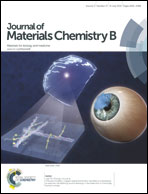A water soluble initiator prepared through host–guest chemical interaction for microfabrication of 3D hydrogels via two-photon polymerization
Abstract
Hydrogels with a precise 3D configuration (3D hydrogels) are required for a number of biomedical applications such as tissue engineering and drug delivery. Two-photon polymerization (TPP) is an advanced method to fabricate 3D hydrogels. However, TPP of 3D hydrogels has been challenged by the lack of TPP initiators with high efficiency in aqueous medium. In this study, a water soluble TPP initiator (WI) with high fabrication efficiency was prepared by combining hydrophobic 2,7-bis(2-(4-pentaneoxy-phenyl)-vinyl)anthraquinone (N) with a C2v symmetrical structure and 2-hydroxypropyl-β-cyclodextrins through host–guest chemical interaction. Both one and two-photon optical properties of WI have been investigated. In aqueous medium, WI showed a two-photon absorption cross-section of around 200 GM at the wavelength of 780 nm which was much higher compared with those of commercial initiators. The threshold energy of TPP for the resin with WI as a photoinitiator (the molar ratio of N in resin is 0.03%) was 8.6 mW. 3D hydrogels with a woodpile microstructure were further fabricated by using an average power of 9.7 mW and a scanning speed of 30 μm s−1.


 Please wait while we load your content...
Please wait while we load your content...